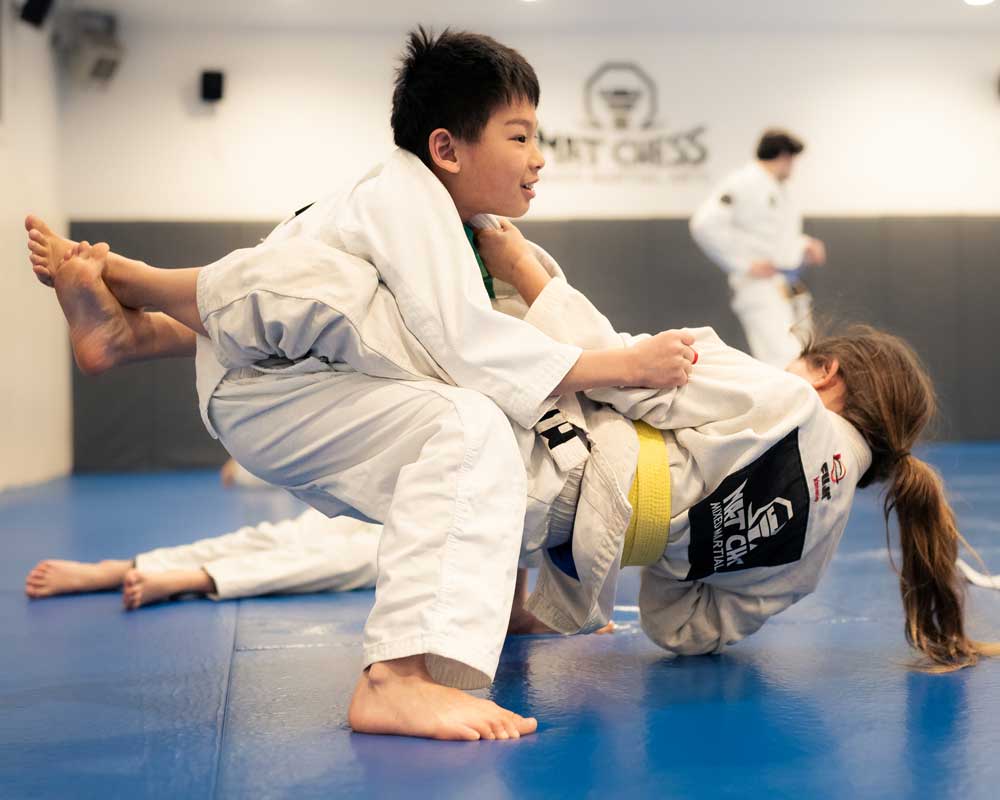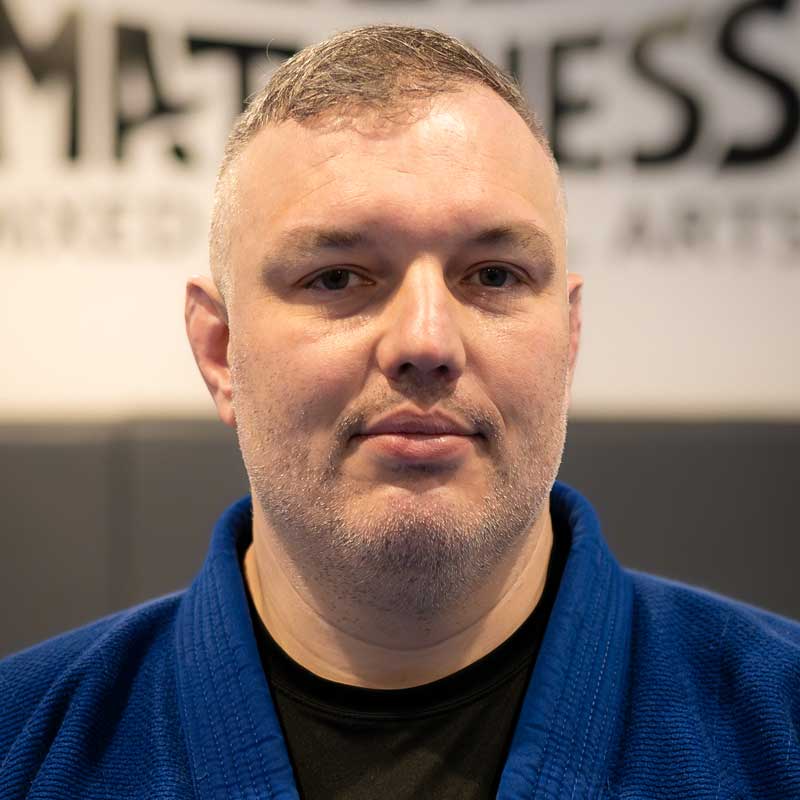A Class Designed for Children, by
Child Education Experts
Sound too good to be true?
It’s true.
Andrew Perkins, our gym owner, runs Mat Chess Kids. He writes the curriculum, oversees all classes and manages how instructors operate classes.
Why does this matter?
Experience…
Andrew’s experience comes from 10-plus years of teaching in Edmonds School District, another 10-plus years of coaching kids and a master’s in education from Boston University.
Why Should Your Child Train BJJ?

Growth With Every Class
As a parent, you know children are like sponges. They absorb things far more quickly than we do as adults.
This makes the extra hours a week socializing, learning skills and building confidence an irreplaceable experience for supporting child development.

Fitness, Disguised As Fun
Between the food we eat and the time spent staring at devices, many kids don’t get enough exercise.
Giving them a chance to exercise and wear themselves out helps them sleep well, stay healthy and develop a healthy mind and body.

Self-Defense
The first step to self-defense, your child’s confidence only grows as they develop their skills. Classes instill this in our students, as well as teach how to defuse tense situations.
And as a martial arts class, they learn the skills, respect and discipline to responsibly protect themselves if needed.

Community
Your child has the chance to make friends from all over the Seattle area at Mat Chess MMA. Our kids’ classes aren’t limited to any single school district, but to anyone who joins — meaning they make connections they never could have otherwise made.

Confronting Adversity
Your child encounters the frustration of losing, being controlled by a smaller but more skilled opponent.
This is a learning and growth opportunity to develop self-control and calmness under stress — serving them throughout life.

Conduct When Winning and When Losing
Students have plenty of opportunities to both win and lose while here. In that experience, they have opportunities to learn grace in loss, as well as respect and self-control in victory.
Kids’ Martial Arts Classes With Andrew Perkins
We design daily lessons with education in mind.
With a background in children’s education, Andrew draws on that experience when designing all our classes’ curricula, kids’ classes included.
The result is a curriculum that helps your child learn at an accelerated pace, using the same strategies that you’d find in an academic setting.


Class Structure
Every week, we introduce and practice a different fundamental.
Your child learns more details regarding that technique each day of the week, building on new knowledge that they’re actively practicing.
Kids’ Class Structure
- Warm-ups and reviews. The first two minutes of class cover what students will learn throughout the week and that day. If they arrive later in the week, we spend this time reviewing what we’ve already covered. Additionally, we do breathing exercises to help prepare to learn.
- Group fundamental techniques. Students learn and practice the technique we’re learning for the week, drilling to memorize, then with resistance. This ends with “hero rounds,” where we practice with resistance, but “the hero always wins.”
- Supervised sparring. The class breaks down into groups based on skill and size. We also focus on practicing “situationals” — students begin in a specific position and begin the round from that position, such as guard or side control.
- Group quiz. We ensure we’ve covered our learning targets and give students a chance to mentally review what we’ve been practicing before practice ends.
- Thanking each other for practice. This is a few dedicated minutes where everyone shakes hands and thanks their training partners.
Kids’ Martial Arts Instructors
Head Teacher and Program Manager

Andrew Perkins
Andrew holds the following degrees:
- BFA of philosophy from Boston University
- Master’s in teaching from Boston University
He spent nine years teaching the following courses in the Edmonds School District:
- History
- English
- Philosophy, in the program that he started at Lynnwood HS
- Physical education
Andrew has an additional 13-plus years of teaching both children and adults since opening Mat Chess for a combined 20-plus years of experience teaching — and coaching — kids.
Assistant Teachers

Carson

Matt
FAQ
Absolutely! BJJ is a grappling art. As such, it doesn’t include kicking or punching and is similar to wrestling in that regard.
Because of this, kids can spar at full intensity, which safely gives them a lot of experience with a fully resisting opponent. We’ve had students who’ve encountered self-defense situations that they couldn’t deescalate. And we’re proud to report that each student was able to keep themself safe through the conflict.
Absolutely! We have students of all sizes and skill levels, so they always have a productive training partner to work with.
One of the hopes of martial arts is that through training and technique, a smaller practitioner can control a bigger, stronger opponent. Students realize this hope during every Brazilian jiu-jitsu training session!
BJJ is tough, and losing at sparring can be intense.
When you lose at basketball, someone put a ball into a hoop more times than you. When you lose at BJJ, someone physically controlled and dominated you. This can be intense and difficult to deal with. Kids also fall funny and get bumped during training. It’s not uncommon for kids to say they want to quit after a hard sparring session or a funny fall.
We find that BJJ gives students a healthy bit of frustration — and that the experience of going through frustration can be of enormous value.
Year in and year out, we see kids (and adults, for that matter) being able to deal with life’s frustrations a bit more easily after their BJJ experience. Life outside the mats seems a little less intense thanks to their experience.
Again, going through something difficult like BJJ and coming out on the other end can be a confidence-boosting experience. We find that once they have another good day of sparring, they’re back to enjoying training and having great fun on the mats. Almost without fail, every kid who’s been training more than a year has had a moment when they’ve asked to quit.
Most of those who stuck with it were able to experience the tremendous value that BJJ training can provide. We find that a little calm and staying the course go a long way in their human development — and we hope you find the same.
As with any sport, there’s always risk of injury. That said, we haven’t seen a serious injury stemming from kids’ BJJ training since our 2011 inception.
This is quite a powerful statement, given the thousands of kids who have been on our mats. Personally, we were injured far more frequently while playing basketball as kids than while training BJJ as adults.
Absolutely not! Almost all kids who come in have never trained before. Plus, we have a robust system to orient new students and teach them the fundamentals.
Our kids’ martial arts class starts at age 5. At that age, we find students have the concentration necessary to pick up technique efficiently.
Through experience, we’ve learned that starting kids too early can lead to them feeling frustrated. This also risks losing their long-term martial arts enjoyment and progress.
Because karate and TKD are striking arts with kicking and punching, it would be highly dangerous and irresponsible to have kids spar at an intensity replicating a self-defense situation.
As a result, karate and TKD for kids often focus on forms and theory rather than the practical application of technique in a high-intensity environment. BJJ, being a grappling art, allows for safe sparring at full intensity because it doesn’t include striking. This gives students a lot of experience with fully resisting opponents, similar to what they’d experience in a self-defense situation.
Additionally, it allows BJJ to be a fantastic sport. We have many kid competitors who benefit from having an excellent competitive outlet. BJJ is also a fantastic problem-solving intellectual puzzle that keeps both kids and adults engrossed for years to come!
We start integrating students into our adult program around high school.
At that time in their development, we find students can better handle the weight of adults and make use of the more nuanced and detail-oriented techniques we teach in adult class.
We designed our program to escape the seasonality of sports and allow your child to train year-round. In addition, we start class early so that our program doesn’t typically interfere with students’ other activities.
Our membership also includes unlimited access to classes, and we offer our kids’ class Monday through Friday from 4 to 5 p.m. There’s no need to sign up for specific days — simply come in when it suits you all best.
We also have many soccer families who come in a bit less during soccer season and a bit more outside of season. Our program is flexible and fits around the other things your busy student does!











